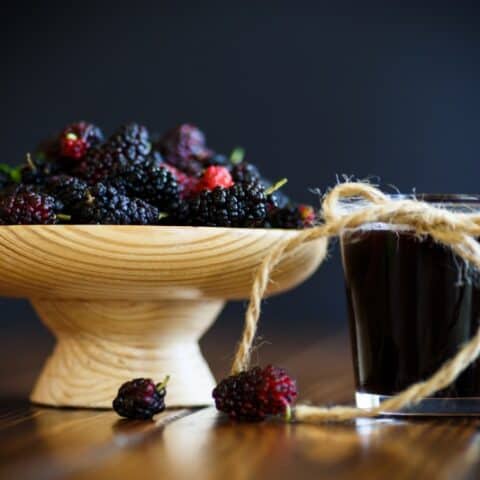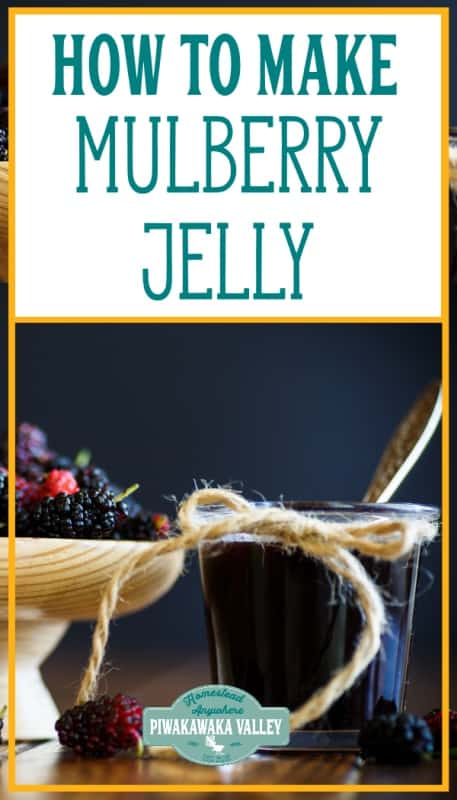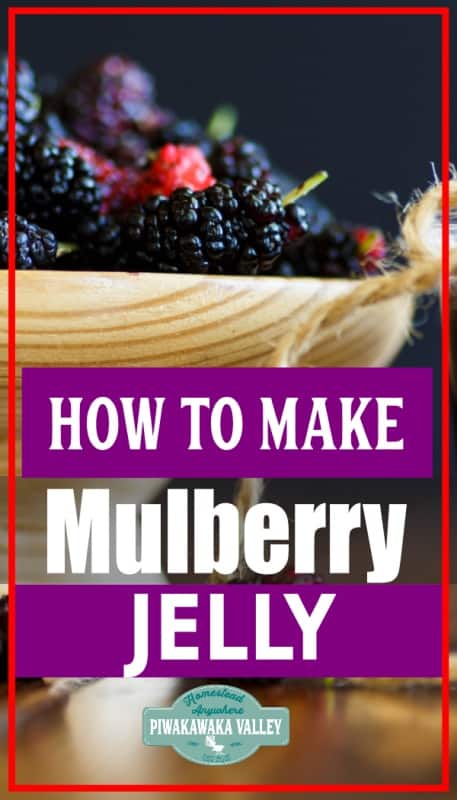This post was most recently updated on January 31st, 2022
Before I started on my food forest growing journey, I had never heard of mulberries! They are also known as Shahtoot or Morus Alba.
Please read: This information is provided for educational purposes only and is not intended to treat, diagnose or prevent any disease. We encourage you to make your own health care decisions in partnership with a qualified health care professional.
This post contains affiliate links, this means at no extra cost to you, we make a commission from sales. Please read our Disclosure Statement
Making mulberry jelly is really appealing to me, because to make mulberry jam, you have to remove all the stems by hand before making the jam.
With making jelly, you juice the fruit and strain out all the chunky bits before you cook it up and this, while it is an extra step, it really does make the process easier.
What are mulberries?
For those unfamiliar with mulberries, they are a very sweet, deep purple berry (some varieties are red, but there are white, black, and blue versions of them too!) that looks a lot like a blackberry but they are longer, more slender with finer seeds.
Mulberry trees can grow up to 10 feet per year and reach full maturity at 30 feet. They are deciduous, meaning they loose their leaves over winter. The leaves are the favorite food of silkworms.
Mulberries ripen over a few months and fully mature in late Autumn/fall.
The benefits of mulberries
Mulberries, like many berry fruits are nutrient powerhouses full of goodness.
They are high in vitamin C, B-2, K and many antioxidants and have been shown to boost your immune system.
Mulberries have been shown to improve digestion, relieve constipation and have been used by some to help lose weight.
Certain chemicals present in white mulberries are similar to the medicine used to treat type 2 diabetes and have been shown to lower blood sugars in diabetics in some cases (1).
Due to their antioxidant content, they have been shown to reduce cancer risk and improve heart and eye health (2).
Jam, jelly or preserve, what is the difference?
Jelly is made from strained fruit juice and is gelatinous and clear. Jam is made from pulp, pureed, mashed or smashed fruit and is softer, more spreadable than jelly.
Preserves are made from pieces of fruit, with it being looser than jam, spoonable rather than spreadable.
Marmalade is usually made from citrus fruit, sometimes containing chards of rind or bits of zest, and, it has a consistency between jelly and jam.
RELATED POST: What to do when your jelly doesn’t set
Supplies for Making Mulberry Jelly
You will need some supplies to make this mulberry jelly at home. Below are a few options for you to extract the juice from the fruit so what you are making is a jelly, not a jam.
1-2 Large pots
I suggest you have a large pot, or two would be even better. You need to tip the fruit from a hot to a large piece of cheese cloth or other food-safe fabric to remove the juice before making the jelly. Having 2 pots, or a pot and a large bowl will help make less mess!
A way to juice the mulberries
To get the juice out of the mulberries you can use a variety of methods. If you have a juicer, you can use that, it is probably the easiest option and avoids having to strain the fruit in a cloth.
The way we use, as we do not have a juicer, is to heat the berries in a pot while crushing them with a potato masher to help them release their juices.
Then I allow them to cool enough to handle them and I tip them in to a large colander lined with a double layer of cheese cloth or muslin sat over a second pot, a jelly bag like this would be really helpful. Then I scoop up the edges of the cloth and tie it over a wooden spoon handle and I leave it dripping until all the juice is out.
Another option for juicing your mulberries for making jelly would be to place them in batches in to a food processor or blender and then strain them as above through either a fine sieve (you can use the bottom of a ladle to squish the juice through) or a cloth.
Jars and lids
Jam or jelly can be made in old jam jars that have been sterilized as long as the lids are in good condition. However, the recommended method is to put jam and jelly in to preserving jars with new seals and bands.
Commercial jam jars are really designed to be used just once, but my grandma used to use them many times, so I will leave that choice up to you.
A waterbath canner or large pot and rack
Traditionally, we did not waterbath jams or jellies, but this has changed now that we understand more about food preservation. It is now recommended that all preserves are at least waterbathed for 10 minutes in rolling boiling water to ensure all bugs are killed and the jars seal correctly.
You cannot sit jars directly on the bottom of your pot – they will explode, you need a metal rack to keep them off the bottom, most water bath canners come with these already.
A jar lifter
You will need some way of lifting the jars in and out of the boiling water. Waterbath canners often come with a basket that means that you can lift all your jars in and out at once. Otherwise one of these is necessary.
Pectin
Some fruits, like apples, apricots, citrus fruits and cherries, are really high in pectin. Others, like berries, are not. Pectin is a naturally occurring part of fruit, and the powder or liquid that you buy is usually made from apples.
Pectin requires sugar and some citric acid to work, and while if you don’t mind runny jelly it is not essential, it is a helpful addition to ensure that your jelly and jam set up well.
RELATED POST: What to do when your jam doesn’t set
Water bath processing times for mulberry jelly
| Recommended process time for Mulberry Jelly with powdered pectin in a boiling water canner. | ||||
| Process Time at Altitudes of | ||||
| Style of Pack | Jar Size | 0 – 1,000 ft
0-300m |
1,001 – 6,000 ft
300-1800m |
Above 6,000 ft
Over 1800m |
| Hot | Half-pints or Pints
250ml or 500ml |
10 min | 15 | 20 |
A easy and delicious way to make mulberry jelly at home 1. Juice your mulberries. Either use a juicer, blitz in the food processor and strain or use the following method. Put the mulberries in a large saucepan and crush. Heat gently until the juice starts to flow, then simmer, covered for about 15 minutes. Allow to cool somewhat. Put in a jelly cloth or bag, or strain through several layers of damp cheese cloth. Squeeze out the juice. 2. Measure 3 cups of juice into an 8 liter / 8 quart saucepan. 3. Add the lemon juice and sugar, and mix well. 4. Put over high heat and bring to a boil, stirring constantly. When it has reached a full, rolling boil, stir in the liquid pectin. While this is happening, heat your jars for 10 minutes in a low oven. 5. Continue to stir and return the juice mixture to a full, rolling boil. Boil for 1 one minute, stirring constantly. 6. Remove the pan from the heat carefully. 7. Skim off any foam with a large spoon 8. Pour your jelly into hot, sterilized jelly jars, filling to 1/4-inch from the rim of jar. 9. Put on the lids and process in a boiling water-bath canner for 10 minutes. 10. Remove the jars of jelly and let them cool on a wire rack or thick folded towel for at least 12 hours. You can use powdered pectin if you cannot find liquid pectin. You will need 1.75oz or 50g of powdered pectin for this recipe and you will need to stir it through the cooled juice just after straining and before boiling it. I find a whisk helpful to mix it through.
Mulberry Jelly Recipe
Ingredients
Instructions
Notes



